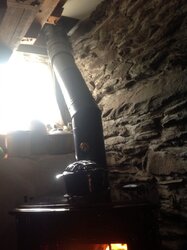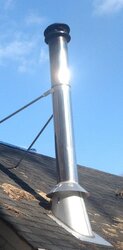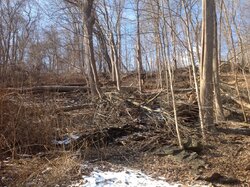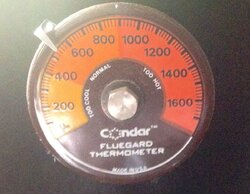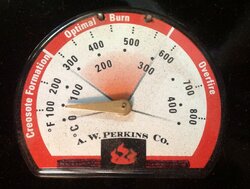i used to just put in a couple of splits in every three hours or so. I will still do that during the day and then burn down the coals now and again. Have to load it up at night so it keeps going and has some left to start up again in the morning. seems to burn ok loaded up and never got about 600-650. When i just had a couple of small splits it can get up to 700 even with the air turned down. seems to do a better job when it is loaded and goes thru the cycle.
putting too much wood in stove
- Thread starter wood burning cop
- Start date
-
Active since 1995, Hearth.com is THE place on the internet for free information and advice about wood stoves, pellet stoves and other energy saving equipment.
We strive to provide opinions, articles, discussions and history related to Hearth Products and in a more general sense, energy issues.
We promote the EFFICIENT, RESPONSIBLE, CLEAN and SAFE use of all fuels, whether renewable or fossil.
You are using an out of date browser. It may not display this or other websites correctly.
You should upgrade or use an alternative browser.
You should upgrade or use an alternative browser.
- Status
- Not open for further replies.
swagler85
Minister of Fire
ozzy73
Burning Hunk
I would not load your stove N/S full. Use bigger splits and pack it E/W with the largest in the back.
Make sure got some good coals. Rake them forward.
Load biggest splits in back and pack it tightly with a few smaller ones on the coal bed.
Watch the fire and adjust the damper accordingly.
It takes a little practice, if you dont feel comfy with a big load just work up to it, start with a 1/4 to see how the stove behaves.
It is a PITA to walk up to the stove every hour to toss a few more logs in....once you get the hang of it you will burn in cycles and only load the stove 2 or 3 times day.
Make sure got some good coals. Rake them forward.
Load biggest splits in back and pack it tightly with a few smaller ones on the coal bed.
Watch the fire and adjust the damper accordingly.
It takes a little practice, if you dont feel comfy with a big load just work up to it, start with a 1/4 to see how the stove behaves.
It is a PITA to walk up to the stove every hour to toss a few more logs in....once you get the hang of it you will burn in cycles and only load the stove 2 or 3 times day.
remkel
Minister of Fire
If I am home all day sometimes I will run like this, but for the most part I look to fill every void in the stove.I have never tried a loaded fire box , best I do is 2 large splits. Is anyone loading like this with a non-cat stove?
M
MnDave
Guest
when i only put 3 or 4 small splits in the stove i can get the stovetop temp up to 700 or 750 degrees with the air only open a small amount. at this point i am affraid to put in a good size load for overnight burning. in my belief more wood equals higher btu's and a higher stovetop temp and overfiring. i use an ir thermometer ( the dial kind reads about 50 degrees cooler). is there a way to keep the temp lower when using more wood in the stove. any help or comments would be appreciated.
It is ok to be cautious with a new stove. None of us are going to be there if something goes wrong.
As far as more wood, more BTU's, higher temps... Your right... but up to a limit. Usually either the wood gasses or the air will reach a point which limits the BTU output rate and hense the stovetop temps.
If you are having trouble controlling your stove temps then you may have an air leak or need a damper.
MnDave
M
MnDave
Guest
At those temps you are not going to get an efficient burn. Most of the heat will go up the chimney. You need to get your stovetop temps down more, like 400-450, as long as you like the temp in the house.i try to dial back the air when the stovetop gets to about 350 then again when it gets to about 500. then try to let it cruise and have the air open just a little when it is at 600. goes up to about 700 and then fluxuates back and forth to about 600 to 700 most of the time. just when the secondaries go crazy does it get up above 700. do those temps and settings sound about right or should i have less air sooner.
MnDave
Hearth Mistress
Minister of Fire
I was terrified of loading my stove up when I first started, a few pieces on the coals got me a few hours but not knowing how my stove would react I was hesitant to load up and go to bed. It took me a few times of loading it almost full during the day before I felt confident enough to do it overnight. Now once I load it up and cut back the air a little at a time, the fire settles and I get a steady burn, I just damper down and go to bed, without worry.
My neighbor was harassing me when we first got it, he finally told me "It's a big chunk of metal designed to burn wood for god's sake, just shove it in and let it burn, you can't hurt it and as long as your not stupid about it, you won't burn your house down either" So I did and learned the quirks of my stove as I'm sure most people here did.
Every once in awhile, I get over zealous, the fire gets cranking and I begin to panic as my flue temps hit 1000. then, I run out to check the chimney for sparks, flames, whatever, knowing that by the time I get back inside, it's already settled to a much more comfortable temperature - just the cycle of the fire.
Practice makes perfect, well as close to perfect as we can get!
My neighbor was harassing me when we first got it, he finally told me "It's a big chunk of metal designed to burn wood for god's sake, just shove it in and let it burn, you can't hurt it and as long as your not stupid about it, you won't burn your house down either" So I did and learned the quirks of my stove as I'm sure most people here did.
Every once in awhile, I get over zealous, the fire gets cranking and I begin to panic as my flue temps hit 1000. then, I run out to check the chimney for sparks, flames, whatever, knowing that by the time I get back inside, it's already settled to a much more comfortable temperature - just the cycle of the fire.
Practice makes perfect, well as close to perfect as we can get!

Seasoned Oak
Minister of Fire
My stove burns more efficiently at the higher temps. my secondaries go out below 350 stovetop. at 500-600 stovetop the whole ceramic reburn chamber is cherry red.At those temps you are not going to get an efficient burn. Most of the heat will go up the chimney. You need to get your stovetop temps down more.
MnDave
M
MnDave
Guest
Keep in mind that I was quoting his 600-700 temps from an earlier post. I see that he got it down some.My stove burns more efficiently at the higher temps. my secondaries go out below 350 stovetop. at 500-600 stovetop the whole ceramic reburn chamber is cherry red.
I need to read all the posts before commenting. My bad.
MnDave
Wood Duck
Minister of Fire
I find it hard to believe that your stovetop is really 750 degrees with only three small splits. Maybe your thermometer is off. I have a cheap magnetic stovetop thermometer and I am convinced it is off - it reads 200 degrees when the stove is cool, so is it always 200 degrees too high? Who knows.
You could try a second thermometer to see if they are similar. If not, then you'll have to decide which one to trust.
You could try a second thermometer to see if they are similar. If not, then you'll have to decide which one to trust.
M
MnDave
Guest
My neighbor was harassing me when we first got it, he finally told me "It's a big chunk of metal designed to burn wood for god's sake, just shove it in and let it burn, you can't hurt it and as long as your not stupid about it, you won't burn your house down either" So I did and learned the quirks of my stove as I'm sure most people here did.
One never knows if the installation was done right, if the stove is defect free or a crack has developed, or a gasket has failed.
It is easy for someone to harass about your fear when they have no skin in the game. They are not going to be there if things go to hell in a handbag. It can happen very quickly with wood burning and life and property are at stake. I know from experience.
MnDave
Hearth Mistress
Minister of Fire
Yes, I know but I was more paranoid than I needed to be, just fearful of the fire itself. I knew my stove was mint, the install was perfect, even the inspected by the township. I was making myself (and my hubby) nuts, metering every piece of wood, writing it on the splits with a sharpie and keeping a "burn diary" really, I did this for months so afraid I was going to over fire the stove. I had old hearths and fireplaces as a kid/young adult growing up but these new EPA stoves are way different. Now that I've learned the proper way to use my stove, thanks to the folks here, I'm confident, safe AND warmOne never knows if the installation was done right, if the stove is defect free or a crack has developed, or a gasket has failed.
It is easy for someone to harass about your fear when they have no skin in the game. They are not going to be there if things go to hell in a handbag. It can happen very quickly with wood burning and life and property are at stake. I know from experience.
MnDave
 .
.
M
MnDave
Guest
Every once in awhile, I get over zealous, the fire gets cranking and I begin to panic as my flue temps hit 1000. then, I run out to check the chimney for sparks, flames, whatever, knowing that by the time I get back inside, it's already settled to a much more comfortable temperature - just the cycle of the fire.
1000F ? You hit it out of the ballpark. Was that a probe temp? If not then you may have damaged your chimney. Seriously. You may want to have an inspection.
That is not the safe cycle of a woodstove fire. What other dumb things has your neighbor told you?
MnDave
M
MnDave
Guest
but these new EPA stoves are way different.
The EPA stoves limit the minimum air so that you cannot smoke your stove. This is good so that you do not build up creosote as easily but it is bad in the event you forget to close the air soon enough and the stove overfires. 1000F tells me that your stove can draft at a very high rate. What is the lowest temp, with a full load of wood that you can control down to?
MnDave
Hearth Mistress
Minister of Fire
It's a pretty small stove, 1.7 firebox so I get it down to about 300 totally closed down if I do it too quick, drops from 700-800 in minutes, really. It took me a long time to figure out how to keep it coasting around 600 or so. It can easily jump though, I know that. I live In a bank barn on a vertical acre of slate. My installers were afraid I'd have drafting problems because of the valley of the ridge we live on. Even with gusty winds, 50 mph, I don't have trouble or experience a down draft. Our pipe right out of the stove, single wall to a slight elbow 18" above the stove but then its double wall to the ceiling, triple wall through the floor and roof and single wall stainless above the roofline. Because it's pretty much a straight shoot up, It drafts well, too well sometimes 

ethanhudson
Burning Hunk
Certainly Hearth Mistress isn't the only one who has gotten their flue to 1K. I know I have (900 or 950 at least). Do I do it on a regular and intentional basis? No. Have I started a fire and left the door cracked to go make coffee and forgot about the fire, only to come back to a probe thermo at 900-1000 and a hot metal smell? Yes. Have I forgotten to close the bypass on my stove? Yes. Do I make a very conscious effort to ensure that those things don't happen again? Yes, but my flue is rated for 1K degrees on a regular basis (insulated stainless liner with double wall Selkirk stove pipe.) From the installation manual for the stove pipe: "Your Chimney Connector is intended to connect a gas, liquid, or solid fuel appliance normally producing flue gases of 650°C/1200°F (Canada), 540°C/1000°F (US - to the Temperature requirements of UL103HT)"1000F ? You hit it out of the ballpark. You may have damaged your chimney. Seriously. You may want to have an inspection.
That is not the safe cycle of a woodstove fire. What other dumb things has your neighbor told you?
MnDave
I don't want to underestimate the caution with which individuals must treat their stove, I'm just trying to point out that a properly installed and maintained flue is more than capable of handling 1,000 degrees for "normal" amounts of time.
Oh, and for what it's worth, I pack my stove as absolutely full as possible anytime I want a prolonged burn...
Stay Safe and Happy Burning!
Seasoned Oak
Minister of Fire
I can get very high temps(for relatively short duration) with a few small pieces of wood in my country hearth 2000. Its a small stove with a 2.0 CF firebox and thin walls.I find it hard to believe that your stovetop is really 750 degrees with only three small splits. Maybe your thermometer is off. I have a cheap magnetic stovetop thermometer and I am convinced it is off - it reads 200 degrees when the stove is cool, so is it always 200 degrees too high? Who knows.
You could try a second thermometer to see if they are similar. If not, then you'll have to decide which one to trust.
about 650-700 . I could not do the same with the same wood in my larger stoves.
ethanhudson
Burning Hunk
This one is ready to roll for the next 10-12 hours...I put this together a little while ago, and I'm actually having trouble getting it to take off. There are no gaps between the splits to let air up and out. It'll go, but it's taking awhile.
View attachment 86921
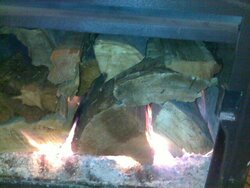
Same load, secondaries only (primary 100% closed), ready for bed...
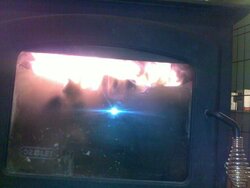
M
MnDave
Guest
I don't want to underestimate the caution with which individuals must treat their stove, I'm just trying to point out that a properly installed and maintained flue is more than capable of handling 1,000 degrees for "normal" amounts of time.
Keep in mind that I do not know what kind of chimney she has. Do you?
Based on what I have read here. A surface temp of 1000F means that the temp of the gas in the flue got to 2000F.
I know that a Class A chimney is rated for 1700 continuous and 2100 peak. I have read that it should be inspected if it hits a high peak because you do not know what real temps were reached and how much accumulated damage there may be.
MnDave
If the flue gases were 1500-2000F with a single wall pipe, I would have expected a couple other visual confirmations. One being the magnetic thermometer sliding right off the flue pipe and two, the pipe glowing bright enough to read by it. Waiting for a confirmation of these visual details.
Dakotas Dad
Minister of Fire
I don't use my foot to force the last split in.. anymore.
But a full stove is essential to the overnight burn.
If I leave my air 80% or more open on a three split load of good wood, I can (and have) see my stove top exceed the 600F max recommendation.
I am pretty sure my probe has never made it all the way to 1000F, but I know it's been past 800F.
But a full stove is essential to the overnight burn.
If I leave my air 80% or more open on a three split load of good wood, I can (and have) see my stove top exceed the 600F max recommendation.
I am pretty sure my probe has never made it all the way to 1000F, but I know it's been past 800F.
Every once in awhile, I get over zealous, the fire gets cranking and I begin to panic as my flue temps hit 1000. then, I run out to check the chimney for sparks, flames, whatever, knowing that by the time I get back inside, it's already settled to a much more comfortable temperature - just the cycle of the fire.
Practice makes perfect, well as close to perfect as we can get!
Is that 1000F


My flue thermometer doesn't even go that high. What are you measuring with? Is this double walled or single walled? Napoleon says the stove top temperature should not exceed 700F or you risk a warped top. How in the world are you getting 1000F in the flue? That really doesn't sound right.
Hearth Mistress
Minister of Fire
Let me clear this up for everyone 
This s a PROBE thermometer, not magnetic, it goes to 1700, it's a Condor Flueguard and yes, It is stuck into the single wall pipe, the first 18" out of the stove. The 1000 is flue gas temp, not stove top temp, my stove top barley gets to 300 as I said, because it's a steel stove with cast iron panels, there is no way to measure the stove top without taking the big heavy piece of cast iron enamel off, which I'm not willing to do everytime I light my stove. I have a stove top thermometer but to me, it's useless. I know if I'm not above 450 flue temp, I'm not producing heat, I coast about 600 most of the time .
Now, to explain my set up, the stovepipe is in my house, all the way to the roof line, weird I know, but when you live in an old house, everything is weird. There is no and has not been any damage, no smell and when the chimney was swept in October, almost a year as a new burner, no creosote, just ash. I'm confident that while my set up is " non traditional" running through my home with big shrouds around it, those pipes never get warmer than "out of the dryer warm" even when the stove is cranking, no glowing pipes, or stove for that matter and nothing but heat ever coming out of the chimney. So, with that, I have to ascertain that I'm burning safe and efficient.
For you curious types, Here are some photos of my set up. That wood in the upper left corner of the stove shot,are my steps, rustic wood blocks bolted together, previous owner made them. This is high temp rated stove pipe, $300 per 36", Killed my budget for the install but needed. It is also what is inside the shroud in my second floor. Yes, I know the cap of my pipe is dented, when that 85ft ash came down during Sandy, a branch hit it. The damage is on the other side of the house - hence the blue tarp, and the cap is being replaced when we take the pipe down to fix the roof in the next few weeks. My installers did not feel it was an emergency repair as the stove hasn't changed behavior since then. Here is the view behind my house, the valley of the ridge we live on. Yes, I see a lot of cutting in my future, that's all from Sandy, 90 mph winds and old trees leave a mess, and we cleared out more than half of it that fell already!
I welcome any comments or concerns with my set up but my township is not the easiest to please and they liked my set up, as do I.
Thanks for all the concern

This s a PROBE thermometer, not magnetic, it goes to 1700, it's a Condor Flueguard and yes, It is stuck into the single wall pipe, the first 18" out of the stove. The 1000 is flue gas temp, not stove top temp, my stove top barley gets to 300 as I said, because it's a steel stove with cast iron panels, there is no way to measure the stove top without taking the big heavy piece of cast iron enamel off, which I'm not willing to do everytime I light my stove. I have a stove top thermometer but to me, it's useless. I know if I'm not above 450 flue temp, I'm not producing heat, I coast about 600 most of the time .
Now, to explain my set up, the stovepipe is in my house, all the way to the roof line, weird I know, but when you live in an old house, everything is weird. There is no and has not been any damage, no smell and when the chimney was swept in October, almost a year as a new burner, no creosote, just ash. I'm confident that while my set up is " non traditional" running through my home with big shrouds around it, those pipes never get warmer than "out of the dryer warm" even when the stove is cranking, no glowing pipes, or stove for that matter and nothing but heat ever coming out of the chimney. So, with that, I have to ascertain that I'm burning safe and efficient.
For you curious types, Here are some photos of my set up. That wood in the upper left corner of the stove shot,are my steps, rustic wood blocks bolted together, previous owner made them. This is high temp rated stove pipe, $300 per 36", Killed my budget for the install but needed. It is also what is inside the shroud in my second floor. Yes, I know the cap of my pipe is dented, when that 85ft ash came down during Sandy, a branch hit it. The damage is on the other side of the house - hence the blue tarp, and the cap is being replaced when we take the pipe down to fix the roof in the next few weeks. My installers did not feel it was an emergency repair as the stove hasn't changed behavior since then. Here is the view behind my house, the valley of the ridge we live on. Yes, I see a lot of cutting in my future, that's all from Sandy, 90 mph winds and old trees leave a mess, and we cleared out more than half of it that fell already!
I welcome any comments or concerns with my set up but my township is not the easiest to please and they liked my set up, as do I.
Thanks for all the concern

Attachments
wkpoor
Minister of Fire
I imagine the 2500 is a close cousin to the Magnolia which I had a few years ago. And yes I had very similar results. It was not controllable with a large load of wood. Maybe you have very god draft like I have. One thing this Hearth crowd doesn't have much experience with is very tall chimneys and how much different any stove will perform on such. The US stoves don't allow you to shut down the primary enough IMO. I routinely had my stove top 750 and above with a damper full closed and had to resort to stuffing the secondary inlet to get it under control.when i only put 3 or 4 small splits in the stove i can get the stovetop temp up to 700 or 750 degrees with the air only open a small amount. at this point i am affraid to put in a good size load for overnight burning. in my belief more wood equals higher btu's and a higher stovetop temp and overfiring. i use an ir thermometer ( the dial kind reads about 50 degrees cooler). is there a way to keep the temp lower when using more wood in the stove. any help or comments would be appreciated.
Hearth Mistress
Minister of Fire
This is my " normal " run rate..... Stove is 2/3 full, lots of coals air in almost all the way. That Perkins is the stove top, useless but it amuses me. Now, It's 45 degrees here today, since the hubby is working, I'm goin out to split (not by hand, screw that, I have a little splitter) I look forward to everyone's comments, know I love you guys and appreciate the feedback 

Attachments
- Status
- Not open for further replies.
Similar threads
- Replies
- 34
- Views
- 3K
- Replies
- 11
- Views
- 633
- Replies
- 68
- Views
- 2K
- Replies
- 12
- Views
- 2K


